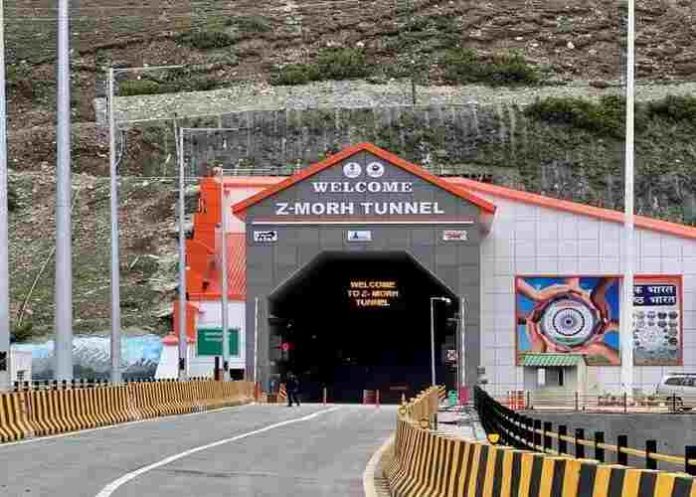Z-Morh: A game-changer for all-weather access to Ladakh
Prime Minister Narendra Modi is set to inaugurate the Z-Morh tunnel on January 13, marking a significant milestone in ensuring year-round connectivity to Ladakh via the Srinagar-Leh National Highway.
Situated at an altitude of 8,652 feet above sea level, the 6.5-km, two-lane tunnel links Gagangir, located 68 km from Srinagar, with the scenic town of Sonamarg. Named after the Z-shaped stretch of road it bypasses, the tunnel eliminates the avalanche-prone section of the route that was often blocked for months due to heavy snowfall. Travel time through this segment will now be reduced from over two hours to just 15 minutes.
Construction of the Z-Morh tunnel began in May 2015 under the National Highways Authority of India (NHAI). This is part of the broader Zoji La Tunnel project aimed at establishing uninterrupted road access between Ladakh and Srinagar.
Strategic Importance
The Zoji La Tunnel, a 14-km U-shaped structure currently under construction further east, will bypass the 11,575-foot-high Zoji La Pass, one of the world’s most treacherous. Once completed in about two years, the Zoji La Tunnel will significantly bolster India’s defense posture in the Ladakh and Kargil sectors, where Indian troops are stationed along the Line of Control with Pakistan and the Line of Actual Control with China.
The commissioning of the Z-Morh Tunnel will benefit the civilian population of Sonamarg by providing them with reliable access to Srinagar and Jammu for daily needs. Additionally, it is expected to boost tourism in the area, a major contributor to the region’s economy.
Future Tunnel Projects
The Z-Morh tunnel is part of a larger effort to improve connectivity to Ladakh and other northern border areas. On the Manali-Leh axis, the Atal Tunnel under the Rohtang Pass was inaugurated in 2020, and work is underway on the Baralacha La Tunnel at the Himachal-Ladakh border. Additional tunnels are planned under the Tangang La and Lachung La passes in Ladakh, all located at elevations exceeding 15,000 feet.
A third route from Manali to Leh, via the Zanskar Valley and the 16,800-foot Shinku La Pass, has recently opened. Construction of a tunnel under Shinku La has already received environmental clearance, further enhancing connectivity.
These projects fall under the Centre’s India-China Border Roads initiative, a comprehensive programme to build critical infrastructure along the northern and northeastern borders. The initiative involves constructing thousands of kilometers of roads, bridges, and tunnels, with contributions from organisations like the Border Roads Organisation (BRO), NHAI, and private entities.
Significance for Defence
In winter, when roads are blocked, the sustenance of troops in the region relies heavily on Indian Air Force transport aircraft and helicopters. Year-round road access will significantly reduce reaction times, facilitate the movement of heavy equipment, and enable cost-effective logistics. For civilians, it promises better access to healthcare, education, and economic opportunities.
Once the network of tunnels is complete, Ladakh and Kargil will enjoy all-weather connectivity via three routes — one from Srinagar and two from Manali. This will provide not only strategic advantages but also a massive boost to the socio-economic development of the region.
A key project to counter challenge posed by China, Pakistan: Expert
The Z-Morh tunnel in Ganderbal district of Kashmir, which will be inaugurated by Prime Minister Narendra Modi on Monday, holds significant strategic value as it will connect Gagangir with Sonamarg. Once completed, the Z-Morh tunnel, along with the ongoing Zojila tunnel project, will ensure faster movement of security forces to Ladakh.
The idea to connect Ladakh with the Kashmir region through the Z-Morh and Zojila tunnels emerged after the difficulties faced by the defense forces in sending supplies to Kargil during the 1999 war. Upon completion, the two tunnels will provide all-weather connectivity to Ladakh, a region that often remains disconnected from the rest of the country for months due to heavy snow accumulation.
Strategic experts highlight that the inauguration of the Z-Morh tunnel brings India closer to achieving an all-weather surface connection with Ladakh.
Professor Virender Koundal, Director of the Strategic and Regional Studies department at the University of Jammu, told The Tribune that once the Zojila tunnel is completed, “India will have geo-strategic dominance over Pakistan and China,” as it will enable rapid troop movement to the region. He further explained that during the 1999 war, the defence forces struggled to send supplies and artillery to the forward areas bordering Pakistan. However, with the completion of the Z-Morh and Zojila tunnels, the defence forces will gain a strategic advantage, enabling them to quickly deploy heavy artillery to Ladakh.
The Zojila tunnel project site is located along the existing highway that connects Sonamarg to Minamarg in Ladakh, at elevations ranging from 2700 meters to 3300 meters. Several bridges are being constructed along this route, and a connecting tunnel from Z-Morh to the Zojila tunnel is also under construction in the Zojila Ghats which will connect Sonamarg and Kargil.



